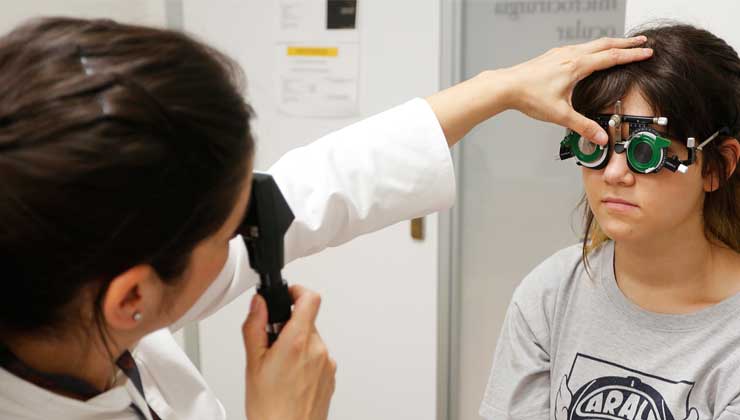Children
12 de April de 2022
When and how often should you visit the ophthalmologist?
Check-ups should take place every year for life if a refractive error or other eye problem exists
Birth
To rule out congenital abnormalities: congenital glaucoma, cataracts, strabismus and ptosis, malformations, tumours.
At 3-4 years
First complete eye examination, visual acuity (lazy eye), ocular motility (strabismus), optical power with drops, fundus. Then, annually until the age of 10 (to monitor the development of the visual system) and every two years until the age of 16.

First complete eye examination should take place at birth
Every two years from the age of 10
Visual acuity, motility examination, optical power, assessment of the anterior pole and intraocular pressure, assessment of the fundus. Detection of acquired refractive errors (myopia and astigmatism), strabismus or binocular problems, ophthalmic disorders.
What are the most common eye problems in children?
Amblyopia, also known as lazy eye
Known as “lazy eye” it is characterised by loss of vision in one or both eyes due to lack of use during the period of visual development. Since it is a disorder that originates in childhood, if it is not diagnosed and treated early, it will inevitably continue into adulthood.

Lazy eye shoiuld be diagnosed and treated early
How can it be detected?
It is asymptomatic. Vision in both eyes must be regularly compared (this can be done at home, for instance, by playing “pirates”).
What causes it?
The brain suppresses and stops using images produced by the eye with poor vision, resulting in it becoming lazy.
Causes: Strabismus, refractive errors, others (e.g. drooping eyelids, etc.)
How can it be treated?
By correcting the cause and making the lazy eye work.
Children’s strabismus
Strabismus is a disorder of the visual system in which the eyes are not properly aligned with each other. This results in each eye deviating in a different direction.
What causes it?
Poor control of eye alignment and movement by the brain, secondary to refractive errors, tumours and disorders of the nervous system.
How can it be treated?
The eyes need to be checked to ensure the condition is not associated with a refractive error, and, then, the child has to wear glasses. If it has caused lazy eye, this disorder has to be treated and surgery considered (the surgeon must make the appropriate recommendations to the parents).
Refractive errors in children
Uncorrected optical defects cause bad vision due to objects not being focused correctly on the retina.
In children, this requires special consideration, because visual development occurs in the first years of life, and, therefore, any cause of poor vision in one or both eyes can lead to a lazy eye problem.
If the refractive problem is asymmetrical (higher optical power in one of the eyes), amblyopia is more likely to develop. Symptomatic refractive problems in childhood should be corrected to prevent amblyopia and not interfere with the child’s schooling.

Optical defects require special consideration in children
How do we develop our visual behaviour?
- 31 weeks of gestation: appearance of pupillary light reflex
- Days after birth: eyelid closure in response to light
- 6 weeks of age: reaction to facial expressions
- 2-3 months of age: perception of movement (following bright object)
In premature babies, the entire process is delayed.
Want to know more?
IMO Institute of Ocular Microsurgery
Josep María Lladó, 3
08035 Barcelona
Phone: (+34) 934 000 700
E-mail: international@imo.es
See map on Google Maps
By car
GPS navigator coordinates:
41º 24’ 38” N – 02º 07’ 29” E
Exit 7 of the Ronda de Dalt (mountain side). The clinic has a car park with more than 200 parking spaces.
By bus
Autobus H2: Rotonda de Bellesguard, parada 1540
Autobus 196: Josep Maria Lladó-Bellesguard, parada 3191
Autobuses H2, 123, 196: Ronda de Dalt – Bellesguard, parada 0071
How to arrive at IMO from:
IMO Madrid
C/ Valle de Pinares Llanos, 3
28035 Madrid
Phone: (+34) 910 783 783
See map in Google Maps
Public transport
Metro Lacoma (líne 7)
Autobuses:
- Lines 49 & 64, stop “Senda del Infante”
- Line N21, stop “Metro Lacoma”
Timetables
Patient care:
Monday to Friday, 8 a.m. to 9 p.m.
IMO Andorra
Av. de les Nacions Unides, 17
AD700 Escaldes-Engordany, Andorra
Phone: (+376) 688 55 44
See map in Google Maps
IMO Manresa
C/ Carrasco i Formiguera, 33 (Baixos)
08242 – Manresa
Tel: (+34) 938 749 160
See map in Google Maps
Public transport
FGC. Line R5 & R50 direction Manresa. Station/Stop: Baixador de Manresa
Timetables
Monday to Friday, 09:00 A.M – 07:00 PM




